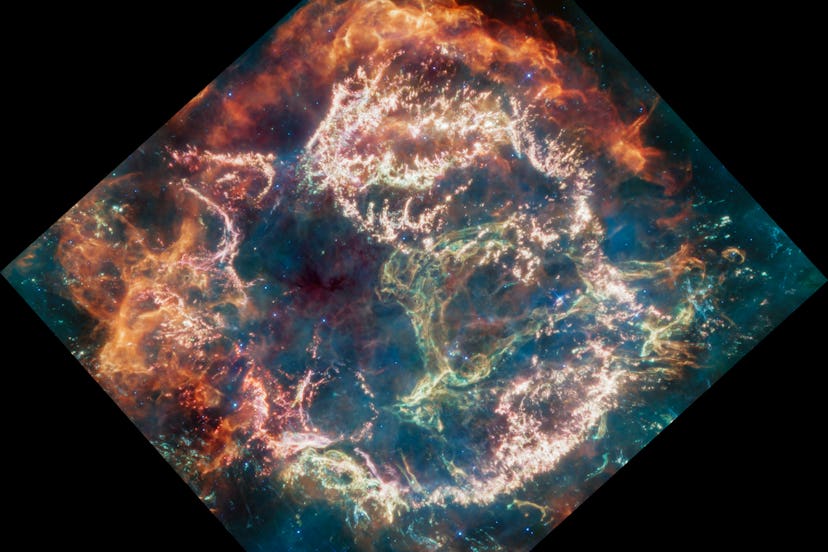This JWST Photo Of The Youngest Known Exploding Star In Our Galaxy Is Incredible
The incredible James Webb Space Telescope (JWST) is back with another wow-worthy picture of Cassiopeia A.

The incredible James Webb Space Telescope (JWST) is back with another astounding image that captured a dramatic — and somewhat rare — space event. As a result, the youngest known star to explode in our galaxy, and what was left behind, can now be studied in these jaw-dropping images.
NASA released the new image in early April, and it shows an incredible picture of Cassiopeia A (Cas A), a supernova remnant that was created 340 years ago, from the perspective here on Earth. It’s the youngest known remnant from an exploding star, and scientists are excited to study it to learn more about why and how these explosions happen.
“Cas A represents our best opportunity to look at the debris field of an exploded star and run a kind of stellar autopsy to understand what type of star was there beforehand and how that star exploded,” Danny Milisavljevic of Purdue University in West Lafayette, Indiana, principal investigator of the Webb program that captured these observations, said, according to NASA.
“Compared to previous infrared images, we see the incredible detail that we haven't been able to access before,” added Tea Temim of Princeton University in Princeton, New Jersey, a co-investigator on the program.
Can you explain what we see in these photos like we’re 5 years old?
This supernova remnant is located approximately 11,000 light-years from Earth in the Cassiopeia constellation, and its full length is 10 light-years. Using the mid-infrared camera from JWST, we can see so much detail — and the scientists are still trying to sort through everything they’re looking at.
The colors in the image alone hold a lot of information. The outer part of the remnant, seen as orange and red curtains of material, shows where ejected material from the exploded star is crashing into surrounding gas and dust.
Inside the remnant, mottled filaments of bright pink represent material from the star itself that is shining due to various heavy elements and dust. There are also fainter wisps of material near the center.
One of the questions scientists hope to answer with Cas A is where cosmic dust comes from. They’ve been able to look at younger galaxies in the universe that have lots of dust, but they’re still trying to formulate where all the dust comes from.
“It’s difficult to explain the origins of this dust without invoking supernovae, which spew large quantities of heavy elements (the building blocks of dust) across space,” NASA notes.
NASA notes that supernovae, like the one that created Cas A, are key for life as we know it because they spread elements like iron and calcium across space — which are necessary for stars, planets, and, well, people.